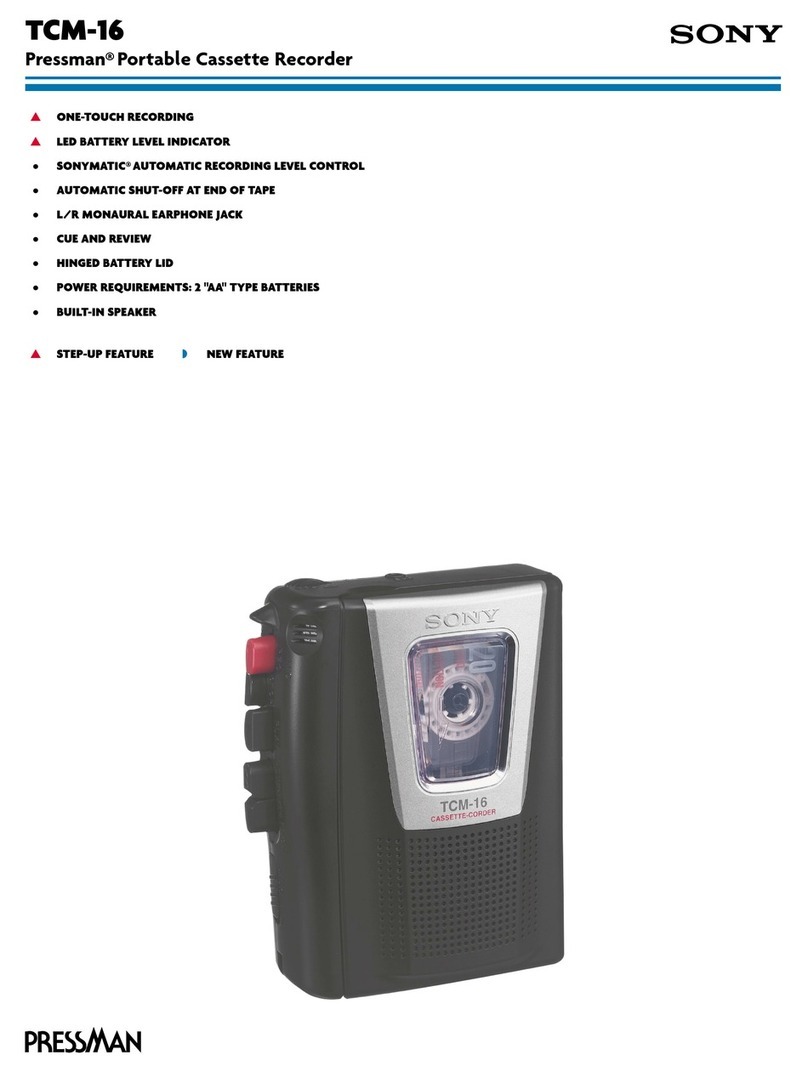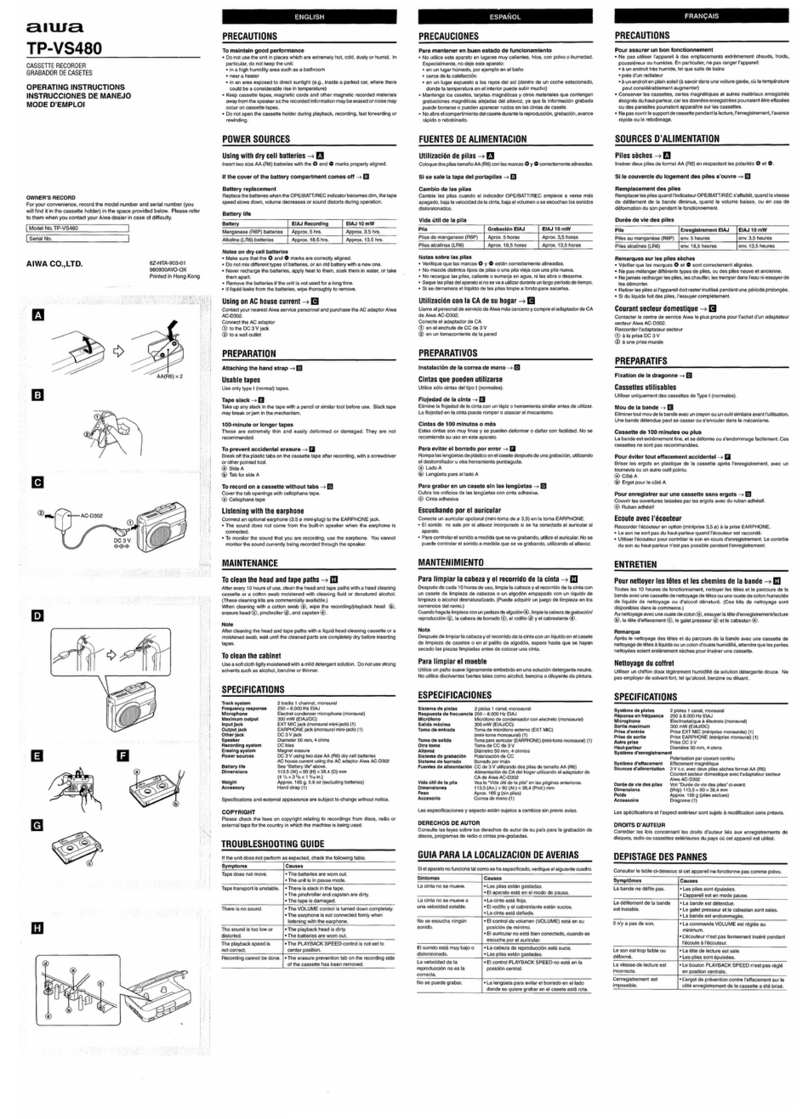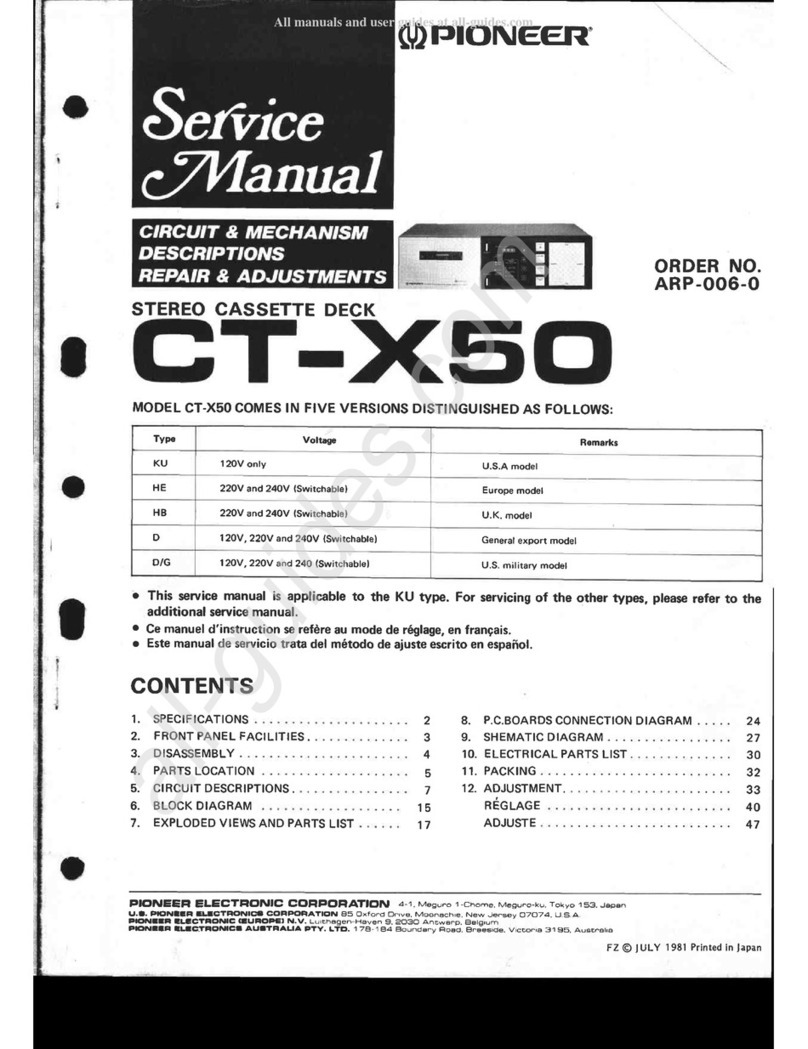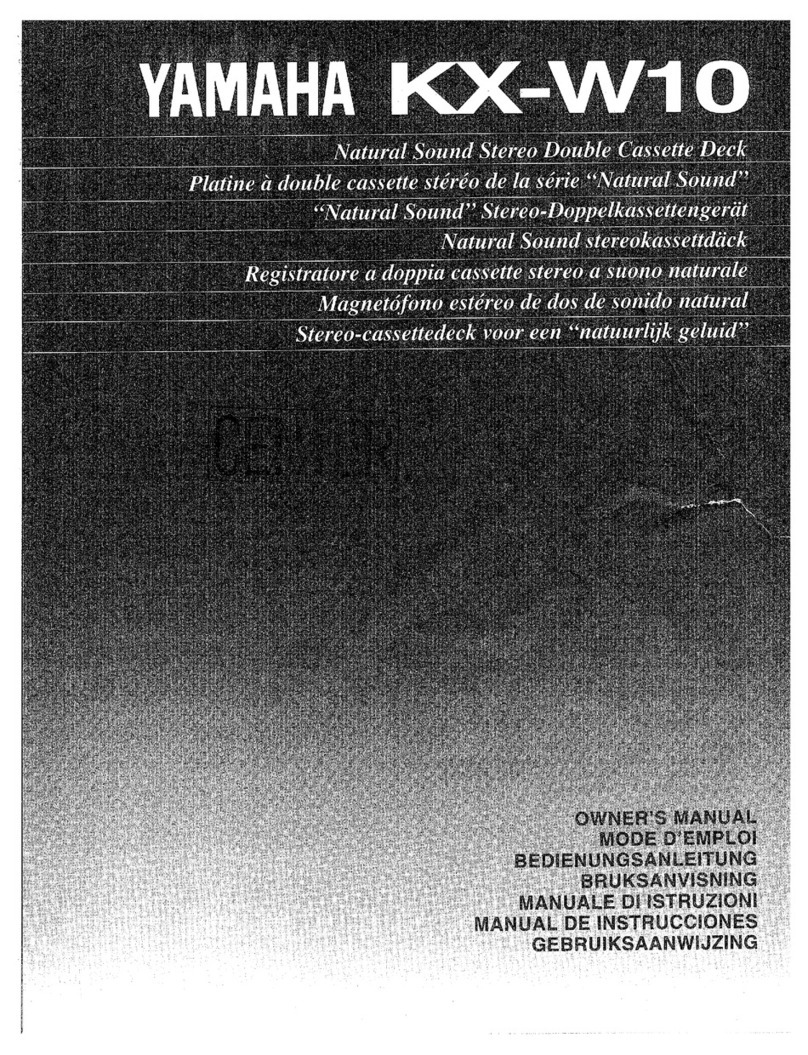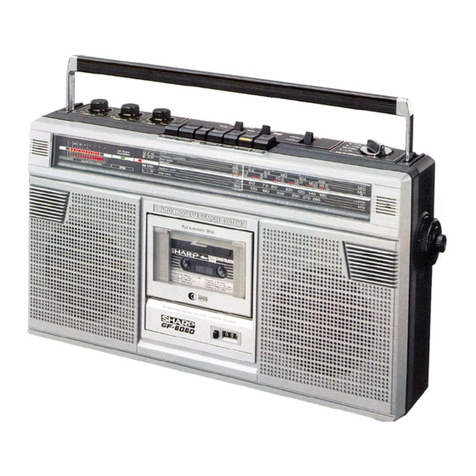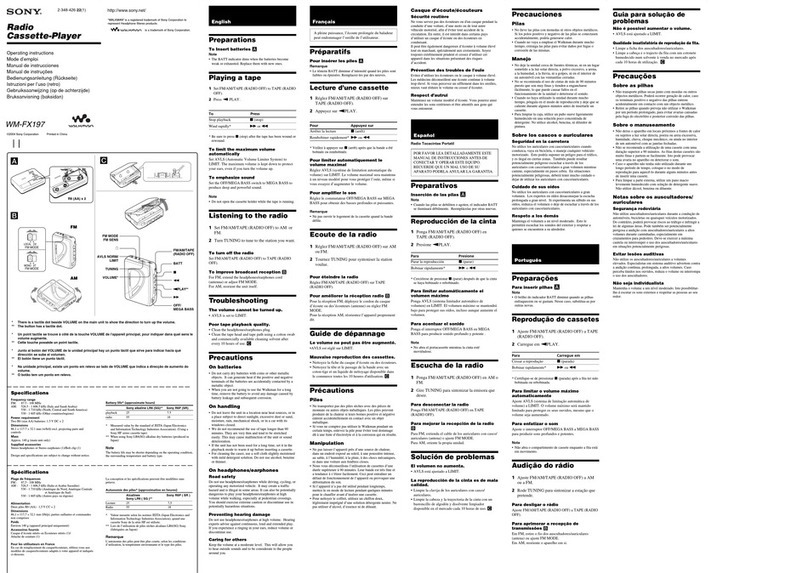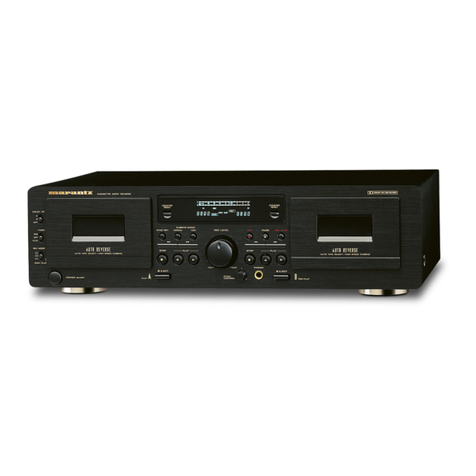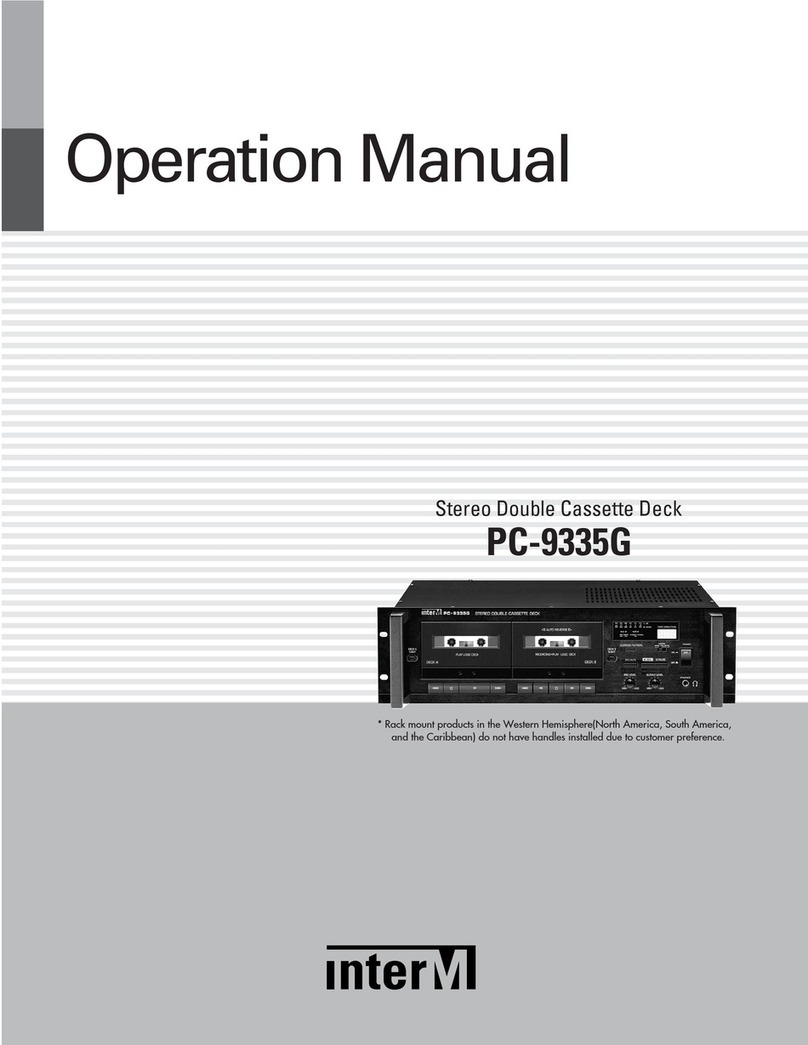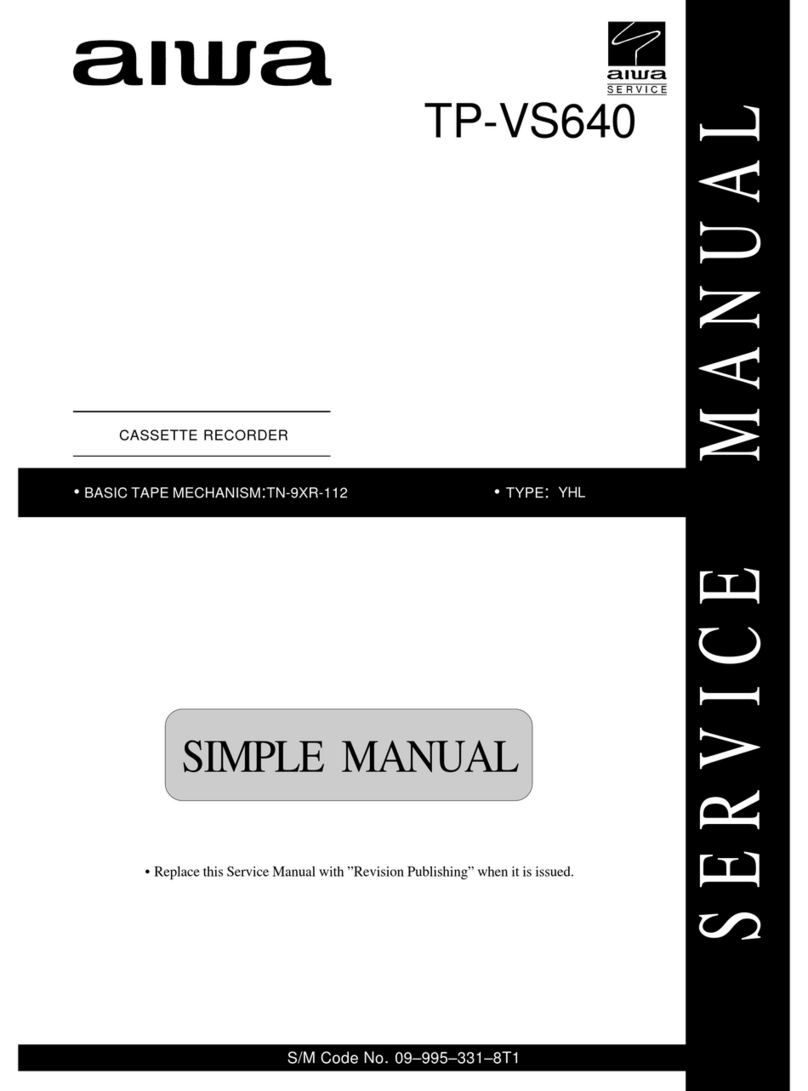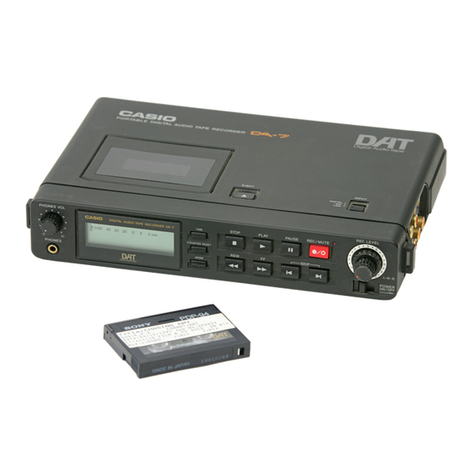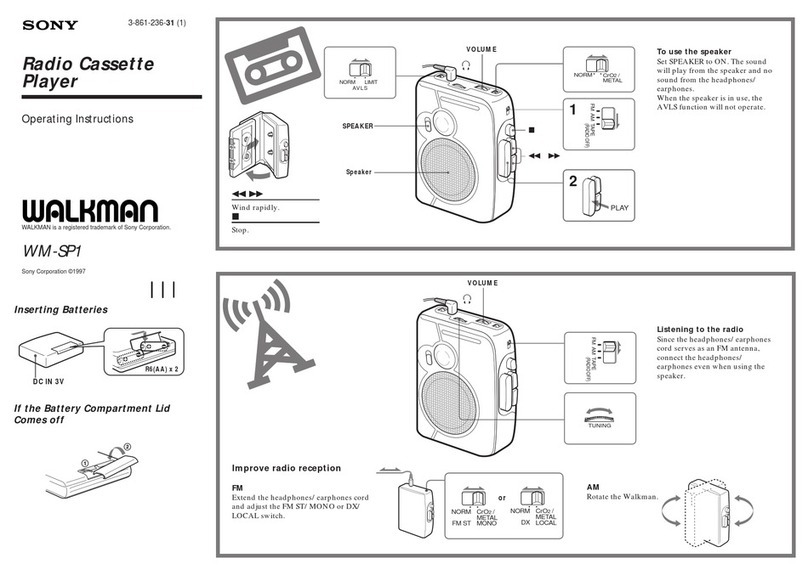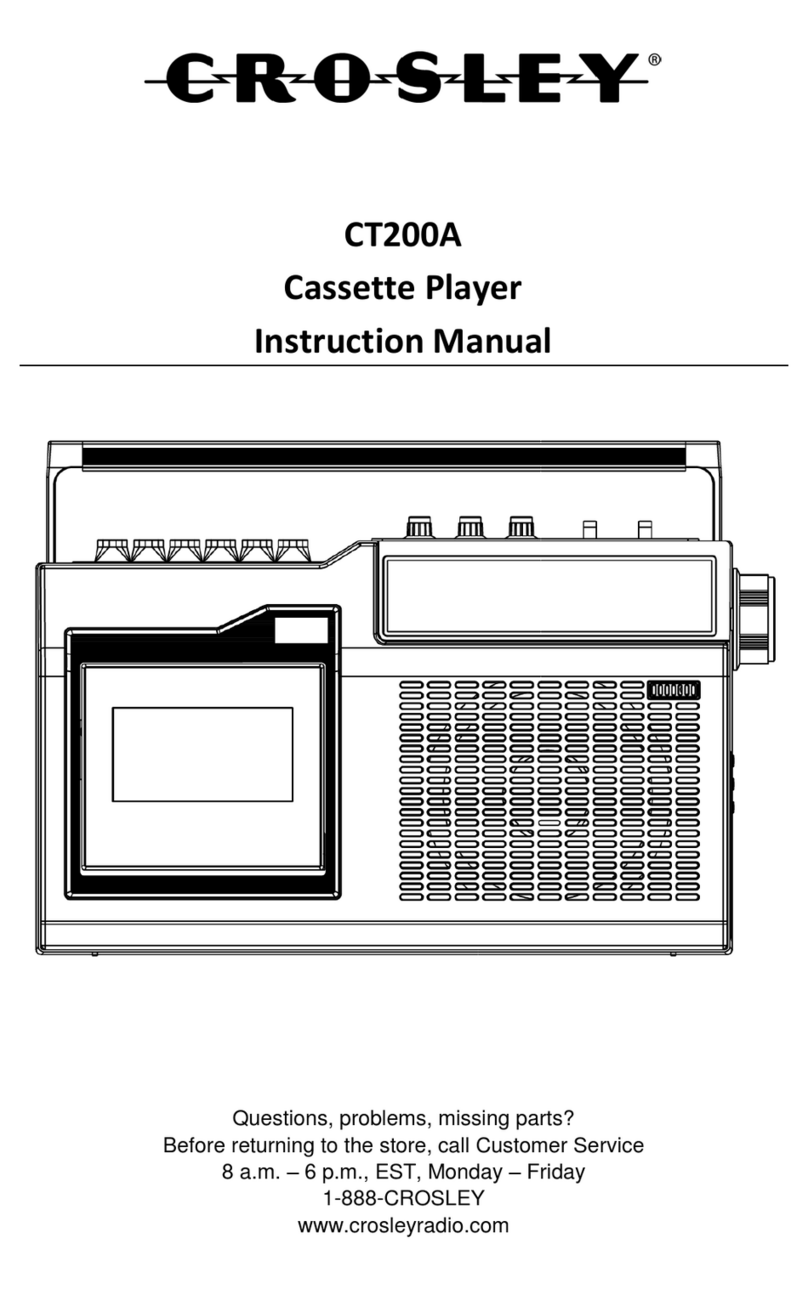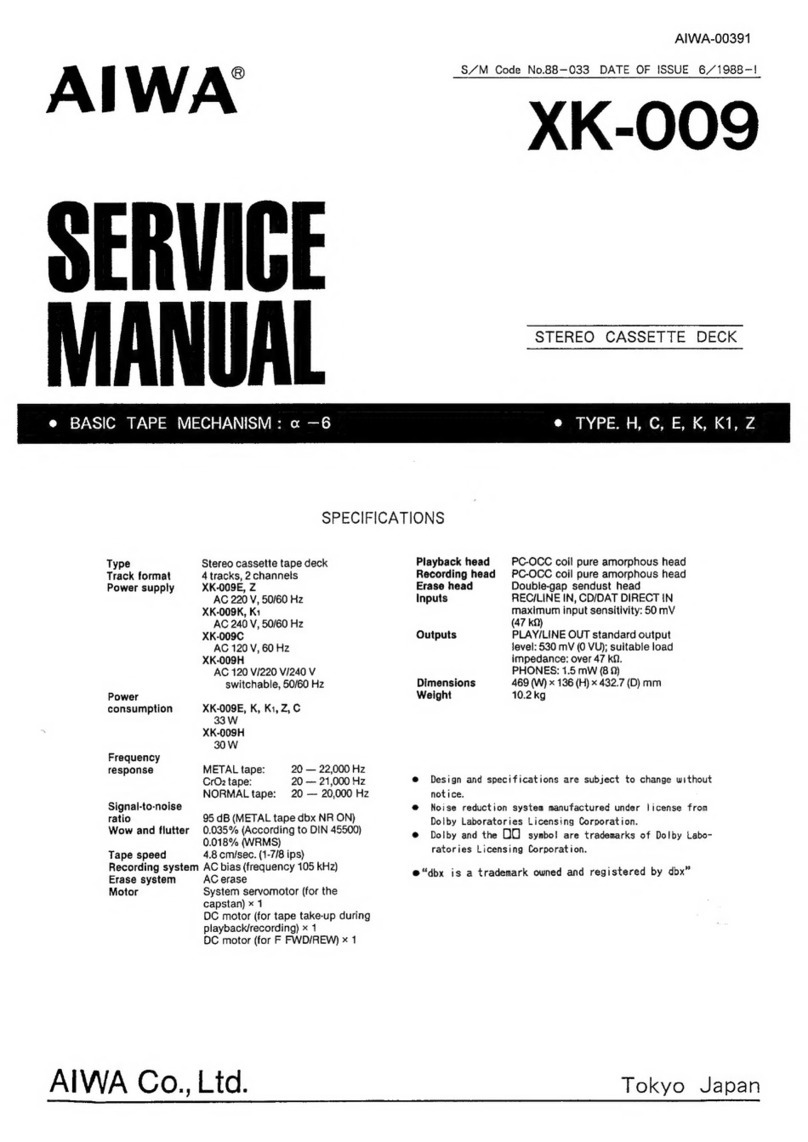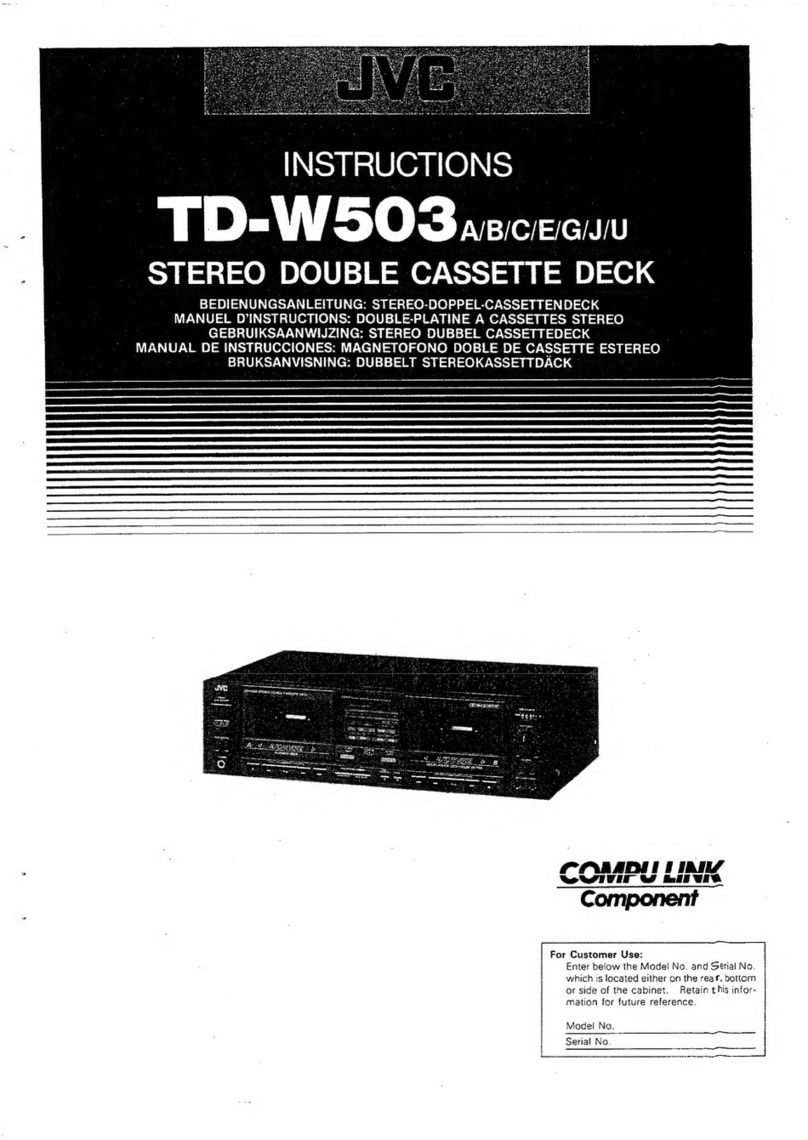Orion COMBI 2612 User manual

SERVICE
MANUAL
ORION
COMBI
2612
/
2612SI
COLOR
TELEVISION/VIDEO
CASSETTE
RECORDER
ORIGINAL
CHASSIS
CODE
B
vis
Best.
Nr.
SM2612
Design
and
specifications
are
subject
to
change
without
notice.

As
for
the
places
which
need
special
attentions,
they
are
indicated
with
the
labels
or
seals
on
the
cabinet,
chassis
and
parts.
Make
sure
to
keep
the
indications
and
notices
in
the
operation
manual.
2.
AVOID
AN
ELECTRIC
SHOCK
There
is
a
high
voltage
part
inside.
Avoid
an
electric
shock
while
the
electric
current
is
flowing.
.
USE
THE
DESIGNATED
PARTS
The
parts
in
this
equipment
have
the
specific
characters
of
incombustibility
and
withstand
voltage
for
safety.
Therefore,
the
part
which
is
replaced
should
be
used
the
part
which
has
the
same
character.
Especially
as
to
the
important
parts
for
safety
which
is
indicated
in
the
circuit
diagram
or
the
table
of
parts
as
a
/\
mark,
the
designated
parts
must
be
used.
.
PUT
PARTS
AND
WIRES
IN
THE
ORIGINAL
POSITION
AFTER
ASSEMBLING
OR
WIRING
There
are
parts
which
use
the
insulation
material
such
as
a
tube
or
tape
for
safety,
or
which
are
assembled
in
the
condition
that
these
do
not
contact
with
the
printed
board.
The
inside
wiring
is
designed
not
to
get
closer
to
the
pyrogenic
parts
and
high
voltage
parts.
Therefore,
put
these
parts
in
the
original
positions.
TAKE
CARE
TO
DEAL
WITH
THE
CATHODE-RAY
TUBE
In
the
condition
that
an
explosion-proof
cathode-
ray
tube
is
set
in
this
equipment,
safety
is
secured
against
implosion.
However,
when
removing
it
or
serving
from
backward,
it
is
dangerous
to
give
a
shock.
Take
enough
care
to
deal
with
it.
SERVICING
NOTICES
ON
CHECKING
1.
KEEP
THE
NOTICES
6.
AVOID
AN
X-RAY
Safety
is
secured
against
an
X-ray
by
consider-
ing
about
the
cathode-ray
tube
and
the
high
voltage
peripheral
circuit,
etc.
Therefore,
when
repairing
the
high
voltage
pe-
ripheral
circuit,
use
the
designated
parts
and
make
sure
not
modify
the
circuit.
Repairing
except
indicates
causes
rising
of
high
voltage,
and
it
emits
an
X-ray
from
the
cathode-
ray
tube.
.
PERFORM
A
SAFETY
CHECK
AFTER
SERVICING
Confirm
that
the
screws,
parts
and
wiring
which
were
removed
in
order
to
service
are
put
in
the
original
positions,
or
whether
there
are
the
portions
which
are
deteriorated
around
the
serviced
places
serviced
or
not.
Check
the
insulation
between
the
antenna
terminal
or
external
metal
and
the
AC
cord
plug
blades.
And
be
sure
the
safety
of
that.
(INSULATION
CHECK
PROCEDURE)
1.
Unplug
the
plug
from
the
AC
outlet.
2.
Remove
the
antenna
terminal
on
TV
and
turn
on
the
TV.
3.
Insulation
resistance
between
the
cord
plug
terminals
and
the
eternal
exposure
meta!
[Note
2]
should
be
more
than
1M
ohm
by
using
the
500V
insulation
resistance
meter
[Note
1].
.
lf
the
insulation
resistance
is
less
than
1M
ohm,
the
inspection
repair
should
be
required.
[Note
1]
If
you
have
not
the
S0OV
insulation
resistance
meter,
use
a
Tester.
{Note
2]
External
exposure
metal:
Antenna
terminal
Earphone
jack
HOW
TO
ORDER
PARTS
Please
include
the
following
informations
when
you
order
parts.
(Particularly
the
CHASSIS
CODE.)
1.
MODEL
NUMBER
and
CHASSIS
CODE
You
can
find
it
in
the
back
of
your
unit.
2.
PART
NO.
and
DESCRIPTION
You
can
find
it
in
your
SERVICE MANUAL.
IN
CASE
OF
VIDEO
TAPE
JAM
|
1.
Remove
the
Deck
Chassis
from
the
main
unit.
(Refer
to
item
1
of
the
DISASSEMBLY
INSTRUCTIONS.)
2.
Rotate
the
Middle
Gear
in
the
direction
of
the
arrow
by
hand.
Then
take
out
the
Video
Tape.
Be
careful
not
to
scratch
on
the
tape.

CONTENTS
SERVICING
NOTICES
ON
CHECKING...
cscccsessscesseseseseensensenseecseesraseaseseassnssssensseesssensenees
A1-1
HOW
TO
ORDER
PARTS
aa
IN
CASE
OF
VIDEO
TAPE
JAM
........ccccscsssseseeseseneennenseecnssessesaeeseenenereecaensessseaserevaecensrcenaenas
At-1
CONTENTS.
iiese.csscvvecsccceativesascosaccdubeucessinsusutcoseciecsueseosssonscanassasaddusesceseesesstdapenesevseedsWesezavusisestieessetes
A2-1
GENERAL
SPECIFICATIONS
0...
cc
cecsesceccseseessescensesenenssnenecasenssnecssessarscnesansanseepeseeseetenanes
A3-1~A3-4
DISASSEMBLY
INSTRUCTIONS
1.
REMOVAL
OF
MECHANICAL
PARTS
AND
P.
C.
BOARDS...
2.
REMOVAL
OF
DECK
PARTS
uu...
eessccsssessssescssseessenecaessesnsacsasnecssessenessettersersaeresenaneatscasansans
3.
REMOVAL
OF
ANODE
CAP
2...
ccscescesssssseeeersecensesseeseecsenssaesansnarsanaeenerecsevaesaesesnenssnsenenacs
4,
REMOVAL
OF
DEFLECTION
YOKE
.........ccssscescesseesessesseesessnnseenassenaseaneaeneescesscesnnsssassaoaees
5.
REMOVAL
AND
INSTALLATION
OF
FLAT
PACKAGE
IC
KEY
TO
ABBREVIATIONS
SERVICE
MODE
LIST
ou...
ccc
cseccsecsseeseceseceessscnscsesssssnsessernsessenersessnenssserasaserensssaecesesesessenerease
PREVENTIVE
CHECKS
AND
SERVICE
INTERVALS
WHEN
REPLACING
EEPROM
(MEMORY)
IC
SERVICING
FIXTURES
AND
TOOLS
MECHANICAL
ADJUSTMENTS
occ
eseccccsscesesssseesennensenesaearererseasseesensenassensensesneensesesenaenaes
_
ELECTRICAL
ADJUSTMENTS.........csssscssessssssessnessneesnssensessarennteraretarecaneennensnesnnennneneneese
BLOCK
DIAGRAMS
POWER/OPERATION....
PRINTED
CIRCUIT
BOARDS
MAIN/CRT
SYSCON/21PIN/DECK
SYSCON/21PIN
....csscssscsecssecsscessarsesneesseseseesusecsesensesesaprensvesessessscanesesananenssvesasocorasesansavaseasroarqneses
F-5,
F-6
SCHEMATIC
DIAGRAMS
Y/C/AUDIO/HEAD
AMP.
.......esescessecsessesssceceesssscesseneseeaeenenssecaessasassaesensenssaeesatenseseesensasnensnaney
G-1,
G-2
MICON
uo.
secsseeseseeneaeeees
POWER/OPERATION
CHROMA
svccicscscssccsvsscontenavs
sasonconcesssauseensosentevsperisasnosidcavansests
ets
pedeeadedessedsetesvrstenedcoss
SOUND
AMP
.....0...:ccssscsscosessssssrssssscersavscssesceoreasenteseesenscssensaseacnsssaserssssnesesneassoessessassoesenseereseess
TTX:
hassncsteccdvccsvsestesessedsodSeasbsivacesunnaicoasecadeduodssastesnsisorsnedevsedersestueconaeersesceuyecbnvecemestecsorates
G-11,
G-12
21PIN/IN/OUT..
G-13,
G-14
TV
POWER
....cccssssssccesssccecsassoenersesoessessnssscvscsssensosossussonsoeusussucsscensensansencacenssaesonenensesssonesenonenecees
G-15,
G-16
DEFLECTION
.
G-17,
G-18
GR
isccecadncacdscevecnccnwcs
shvaeieetuabecivcvesstivccabeeasnncauscubbsoscteiestencsaphduiavesee
sesnesesbs
cade
canesauvatenseptestasvavecdeeus
G-19,
G-20
DECK
...ccsssssocssssssncessssrecsstsecsscscssusessnsnsacsssoccssonvupscosssensscusrsacsansesesossanancassnenesaceasenesesseseesaaseneersses
G-21,
G-22
INTERCONNECTION
DIAGRAM
........ccscsecsesceseesrssesseresescssseccastensecrscnonasensenseeneneestecentenseneniees
G-23,
G-24
WAVEFORMS
MECHANICAL
EXPLODED
VIEWS.
CHASSIS
EXPLODED
VIEWS
occ
cscesccceessseneseeenessscensnseneenessaensspaceseeseseaenessnaseneteesnaeaenenae
MECHANICAL
REPLACEMENT
PARTS
LIST
CHASSIS
REPLACEMENT
PARTS
LIST
...........c:ccsesssesseenecseeetsecnessenersecsesennseassesereeapenseensasenes
J2-1
ELECTRICAL
REPLACEMENT
PARTS
LIST
A2-1

GENERAL
SPECIFICATIONS
CRT
Size
/
Visual
Size
10
inch
/
222.8mmV
CRT
Type
Normal
Deflection
90
degree
Magnetic
Field
BV/BH
+0.45G/0.18G
Color
System
PAL
Speaker
1Speaker
Position
Side
Size
3
inch
Impedance
8
ohm
Sound
Output
System
MAX
10%(Typical)
Player
/
Recorder
Video
System
PAL
Hi-Fi
STEREO
No
NTSC
PB
Yes
Deck
DECK
Loading
System
Motor
OVD-6S
Front
3
Video
Head
2
Head
FM
Audio
Head
No
Audio
/Control
Mono
/
Yes
Erase(Full
Track
Erase)
Yes
Tape
Rec
Speed
PAL
NTSC
SP
Play
PAL
NTSC
SP
SP
Fast
Forward
/
Rewind
Time
(Approx.)
at+250C
Forward/Reverse
Picture
Search
Frame
Advance
Slow
Speed
Broadcasting
System
Tuner
and
Receive
CH
Intermediate
Frequency
Cassette
NTSC
or
PAL-M
PAL
or
SECAM
FF:1'48"/REW:1'48"
at
E-180
SP=3x,5x
SP=5x,7x
1/10
1/5~1/30
CCIR
System
B/G
System
1Tuner
Destination
CCIR
Hyper
Tuning
System
Input
Impedance
VHF/UHF
75
ohm
CH
Coverage
Picture(FP)
Sound(FS)
FP-FS
Preset
CH
E5~E12,$11~S41,E21~E69
Stereo/Dual
TV
Sound
Video
Signal
input
Level 1
V
p-p/75
ohm
Output
Level
1
V
p-p/75
ohm
S/N
Ratio
(Weighted)
53
dB
Horizontal
Resolution
at
SP
Mode
240
Lines
Audio
Signal
Input
Level
-3.8dBm/50Kohm
Output
Level
-3.8dBm/1Kohm
S/N
Ratio
at
SP
42
dB
Harmonic
Distortion
at
SP_(1KHz)
Typical
1.5
%
Frequency
Response
at
SP
100Hz
~10kKHz
at
LP
at
SLP
Hi-Fi
Audio
Signal
Power
Source
Dynamic
Range
:
More
than
Wow
And
Flutter
:
Less
than
Channel
Separation
:
More
than
Harmonic
Distortion
:
Less
than
230V
SOHz
12V
Power
Consumption
Stand
by
(at
AC)
Per
Year
50
W
at
230V
50
Hz
50
W
at12V
6W
at
230
V
50
Hz
Protector
Menu
Power
Fuse
Dew
Sensor
Safety
Radiation
X-Radiation
Operation
Storage
Type
A3-1
+5°C
~
+40°C
20°C
~_
+60"
:
Less
then
80%
RH
j
Yes
Character
E2~E4,
X~Z+2,
S$1~S10,

GENERAL
SPECIFICATIONS
ATS
No
Timer
Rec
Set
Yes
Channel
Setup
4
Yes
Auto
Tuning
Yes
Ch
Mapping
No
Ch
Tuning
Yes
Ch
Allocation
Yes
TV
Setup
Yes
On/Off
Timer
Set
Yes
Picture
Yes
Audio
No
VCR
Setup
No
Auto
Repeat
On/Off
Yes
System
Select
No
Scene
Repeat
No
System
Setup
Yes
Clock
Set
Yes
(Calendar
24h)
Language
Yes
G-CODE(or
SHOWVIEW
or
PLUSCODE)No.
Entry
No
Stereo/Audio
Output
No
Bilingal
No
NICAM
No
Clock/Date
Yes
CH/AV
|
Yes
Tape
Counter(Linear
Counter)
4
Yes
Tape
Speed
\
No
Sleep
Time
Yes
Control
Volume
Yes
Level
Bright
/
Contrast
/
Sharpness/
Color
Yes
Tint
No
Bass/Treble/Balance
No
Manual
Tracking
Yes
Play/Stop/FF/Rew/Rec/OTR/T-Rec/Pause/EjectTape
In
(Symbol
Mark;
Yes
Auto
Tracking/Manual
Tracking
:
Yes
S-Repeat/SR-R/SR-PLAY
i
No
Index
Yes
Mute
Yes
Hi-Fi
No
Repeat
Yes
Zero
Return
No
Dew
Yes
G-11
Clock,
Timer
Calendar
1990/1/1
~
2081/12/31
and
Timer
Timer
Events
8
prog/
1.
month
Back-up
One
Touch
Recording
Max
Time
SP
5
Hours
OTPB
Valid
Time
-
Sleep
Timer
Max
Time
120
min.
Step
i
10
min.
On/Off
Timer
Program{On
Tim
/
Off
Tim)
|
1
prog.
Auto
Shut
Off
No
Signal
15
min.
No
Operation
-
i
Timer
Back-up
(at
Power
Off
Mode)
30
G-12
Remote
Unit
RC-CH
Control
Glow
in
Dark
Remocon
No
Power
Source
Voltage(D.C)
3V
UM
size
x
pcs
UM-4
x
2
pcs
Total
Keys
36
Keys
Keys
Power
Yes
1
Yes
2
Yes
3
Yes
4
|
Yes
5
Yes
6
Yes
7
Yes
8
H
Yes
9
Yes
O/AV
Yes
CH/Tr
Up
No
CH/Tr
Up/Page
Up
Yes
CH/Tr
Down
No
CH/Tr
Down
/Page
Down
Yes
Volume
Up
Yes
Votume
Down
Yes
Play/Up
No
Play/Up/Slow
Yes
F.Fwd/Right
Yes
A3-2

G-14
Features
Accessories
GENERAL
SPECIFICATIONS
Rew/Left
Yes
Pause/Still
Yes
Pause
No
Stop/Down
Yes
Rec/OTR
Yes
Eject
Yes
Counter
Reset
Yes
Speed
No
Timer
Rec
Yes
TV
Monitor
i
Yes
TV
Monitor
/Rec
Monitor
a
No
Program
Yes
Program
V+
i
No
Auto
Tracking
‘
No
Auto
Tracking
/Reveal
i
Yes
Menu
\
Yes
Enter
i
No
Enter/Hold
|
Yes
Cancel/Ch
Skip
No
Cancel/Ch
Skip/F-T-B
Yes
Index
No
Index
/Sub
Page
Yes
Calt
Yes
TexvMix/TV
Yes
Sleep
Timer
Yes
Mute
Yes
Zero
Return
Yes
CM
Skip
No
OTPB
i
No
END
Call
Ele
No
Red
No
Cyan
i
No
Green
No
Yellow
No
‘Audio
Select
No
Auto
Head
Cleaning
Auto
Tracking
HQ
(VHS
Standard
High
Quality)
Auto
Power
On,
Auto
Play,
Auto
Rewind,
Auto
Eject
Auto
Shut
Off
Auto
Repeat
VIDEO
PLUS+(SHOWVIEW,G-CODE)
CH
Auto
Set-Up/Auto
Clock
Forward
/
Reverse
Picture
Search
One
Touch
Playback
Auto
Tuning
Anti-Theft
End
Call
Index
Search
SQPB
CATV
CM
Skip(30sec
x
6
Times)
Comb
Filter
T'Text
Text
type!
Yes
UniText
Scene
Repeat
No
Hotel
Lock
No
TV
Monitor
Zero
Return
Choke
Coil
Power
On
Memory
Owner's
Manual
Language
|
German
w/Guarantee
Card
Yes
Remote
Control
Unit
Yes
Rod
Antenna
Yes
Poles
2pole
Terminal
DIN
type
w/300
ohm
to
75
ohm
Antenna
Adapter
Yes
Loop
Antenna
No
Terminai
-
UN
Mixer
No
DC
Car
Cord
(Center+)
Yes
Guarantee
Card
No
Warning
Sheet
No
Circuit
Diagram
No
Antenna
Change
Plug
'
No
Service
Facility
List
i
No
A3-3

Interface
Set
Size
eal
ass
GENERAL
SPECIFICATIONS
important
Safeguard
No
Dew/AHC
Caution
Sheet
No
AC
Plug
Adapter
No
Quick
Set-up
Sheet
Yes
Battery
Yes
UM
size
x
pcs
UM-4
x
2
pcs
OEM
Brand
No
AC
Cord
No
AV
Cord
(2Pin-1Pin)
No
21pin-RCA
Cable
No
Registration
Card
No
PTB
Sheet
|
No
Anti-Theft
Sheet
No
Euro
Warranty
Information
Sheet
Switch
Power
No
Play
Pause/Stili
System
Select
One
Touch
Playback
Channel
Up
Channel
Down
F.FWD/Cue
Eject/Stop
Main
Power
SW
Volume
Up
Volume
Down
Rew/Rev
Main
Power
SW
Rec/OTR
\
Indicator
Standby
i
Rec/OTR
Red
T-Rec
|
On
Timer
cs
Rec/OTR
One
Touch
Playback
Play
Key
Light
up
Red
Red
pre
EE
1s
eee
aes
No
No
No
No
No
Terminals
Front
Video
Input
Audio
Input
Other
Terminal
Rear
Video
Input
Audio
Input
Video
Output
RCA
x1
RCA
x1
Head
Phone(Stereo
&
Mono,
3.5mm)
No
No
No
Audio
Output
Euro
Scart
N
1-SCART
Diversity
Ext
Speaker
DC
Jack
12V(Center
+)
Yes
VHF/UHF
Antenna
Input
;
DIN
type
AC
Inlet
i
Approx.
WxDxH
(mm):
Net
(Approx.)
Gross
(Approx.)
Master
Carton
No
278
x
312.5
x
311.5
8.8
kg
(
-
Ibs)
10.5
kg
-
Ibs
Content
Material
Dimensions
Wx
Dx
H(mm)
Description
of
Origin
Yes
Material
Double/Full
Color
Dimensions
WxDxH(mm)
338
x
381
x
386
Design
As
per
Buyer's
Description
of
Origin
No
Drop
Test
1
Corner
/
3
Edges
/
6
Surfaces
Height
(cm)
Natural
Dropping
Ati
62
Container
Stuffing(40'
container)
1256
Sets
G-19
Cabinet
Material
Cabinet
Front
j
PS
94HB
Cabinet
Rear
PS
94HB
Jack
Panel
PS
94HB
A3-4

DISASSEMBLY
INSTRUCTIONS
1.
REMOVAL
OF
MECHANICAL
PARTS
AND
P.C.
BOARDS
1-1:
BACK
CABINET
(Refer
to
Fig.
1-1)
1.
Remove
the
4
screws
©.
2.
Remove
the
2
screws
@.
3.
Remove
the
2
screws
@
which
are
used
for
holding
the
Back
Cabinet.
4,
Remove
the
AC
cord
from
the
AC
cord
hook
@.
5.
Remove
the
Back
Cabinet
in
the
direction
of
arrow.
Front
Cabinet
Back
Cabinet
Fig.
1-1
1-2:
CRT
PCB
(Refer
to
Fig. 1-2)
CAUTION:
BEFORE
REMOVING
THE
ANODE
CAP,
DISCHARGE
ELECTRICITY
BECAUSE
IT
CONTAINS
HIGH
VOLTAGE.
BEFORE
ATTEMPTING
TO
REMOVE
OR
REPAIR
ANY
PCB,
UNPLUG
THE
POWER
CORD
FROM
THE
AC
SOURCE.
1.
Remove
the
Anode
Cap.
(Refer
to
REMOVAL
OF
ANODE
CAP)
2.
Disconnect
the
following
connectors:
(CP801
and
CP850).
3.
Remove
the
CRT
PCB
in
the
direction
of
arrow.
Front
Cabinet
1-3:
TV/VCR
BLOCK
(Refer
to
Fig.
1-3)
1.
Remove
the
2
screws
@.
2.
Disconnect
the
following
connectors:
(CP351,
CP401,
CP403
and
CP501).
3.
Unlock
the
support
@.
4.
Remove
the
TV/VCR
Block
in
the
direction
of
arrow.
Front
Cabinet
TVNVCR
Block
1-4:
MAIN
PCB
(Refer
to
Fig.
1-4)
1,
Remove
the
screw
©.
2.
Remove
the
Main
PCB
Holder.
3.
Remove
the
2
screws
@).
4,
Remove
the
screw
@.
5.
Disconnect
the
following
connectors:
(CP502
and
CP820).
6.
Remove
the
Main
PCB
in
the
direction
of
arrow.
VCR
Block

DISASSEMBLY
INSTRUCTIONS
1-5:
DECK
SHIELD
PLATE
(Refer
to
Fig.
1-5)
1.
Remove
the
2
screws
(.
2.
Remove
the
4
screws
@.
3.
Remove
the
screw
©).
4.
Remove
the
Deck
Shieid
Plate
in
the
direction
of
arrow
(A).
5.
Remove
the
screw
@.
6.
Remove
the
Shield
Plate
Bottom
in
the
direction
of
arrow
(B).
Deck
Chassis
Deck
Shield
Plate
1-7:
JACK
PLATE,
21PIN
PCB
AND
SYSCON
PCB
(Refer
to
Fig.
1-7)
1.
Remove
the
screw
©.
2.
Remove
the
Syscon
PCB
in
the
direction
of
arrow
(A).
3.
Remove
the
2
screws
@,
4.
Unlock
the
2
supports
@.
5.
Remove
the
Jack
Plate
and
21Pin
PCB
in
the
direction
of
arrow
(B).
Jack
Plate
Shield
Plate
Bottom
Syscon
PCB
1-6:
DECK
CHASSIS
(Refer
to
Fig.
1-6)
1.
Remove
the
3
screws
©.
2.
Disconnect
the
following
connectors:
(CP1001,
CP1004,
CP1005,
CP1006,
CP4001,
CP4004
CP4005,
CP4503
and
CP4504).
3.
Remove
the
Deck
Chassis
in
the
direction
of
arrow.
Deck
Holder
B1-2

DISASSEMBLY
INSTRUCTIONS
NOTE
When
you
install
the
Tape
Guide
L,
install
as
shown
in
the
circle
of
Fig.
2-3-B.
(Refer
to
Fig.
2-3-B)
2.
REMOVAL
OF
DECK
PARTS
2-1:
TOP
BRACKET
(Refer
to
Fig.
2-1)
1,
Remove
the
2
screws
©.
2.
Slide
the
2
supports
@
and
remove
the
Top
Bracket.
NOTE
When
you
install
the
Top
Bracket,
install
the
screw
(1)
first,
then
install
the
screw
(2).
¢
Screw
Torque:
5
+
0.5kgfecm
2-2:
FLAP
LEVER/TAPE
GUIDE
R
(Refer
to
Fig.
2-2)
1.
Move
the
Cassette
Holder
Ass'y
to
the
back
side.
2.
Remove
the
Polyslider
Washer
©®.
3.
Remove
the
Flap
Lever.
4.
Unlock
the
3
supports
@
and
remove
the
Tape
Guide
R.
Main
Chassis
2-3:
TAPE
GUIDE
L
(Refer
to
Fig.
2-3-A)
1.
Move
the
Cassette
Holder
Ass'y
to
the
back
side.
2,
Unlock
the
2
supports
@
and
remove
the
Tape
Guide
L.
3.
Remove
the
REC
Lever.
(Recorder
only)
Tape
Guide
L
Main
Chassis
*
The
REC
Lever
is
not
installed
on
the
Video
Cassette
Player.
Fig.
2-3-A
B2-1
REC
Lever
*
The
REC
Lever
is
not
installed
on
the
Video
casas
Player,
Fig.
9-3-B
2-4:
CASSETTE
HOLDER
ASS'Y
(Refer
to
Fig.
2-4)
1.
Move
the
Cassette
Holder
Ass'y
to
the
front
side
so
that
the
Link
Ass'y
doesn't
slip
out.
2.
Push
the
Locker
R
to
remove
the
Cassette
Side
R.
3.
Remove
the
Cassette
Side
L.
Main
Chassis
Main
Chassis
Fig.
2-4
2-5:
CASSETTE
SIDE
L/R
(Refer
to
Fig.
2-5)
1.
Unlock
the
4
supports
@
and
then
remove
the
Cassette
Side
L/R.
2,
Remove
the
Cassette
Earth
Spring.
NOTE
1.
When
you
install
the
Cassette
Side
R,
be
sure
to
move
the
Locker
R
after
installing.
2.
After
the
installation
of
the
Cassette
Holder,
then
install
the
Cassette
Earth
Spring.
Cassette
Holder
Cassette
Side
R
Cassette
Side
L
Cassette
Earth
Spring
Fig.
2-5

DISASSEMBLY
INSTRUCTIONS
2-6:
LINK
ASS'Y
(Refer
to
Fig.
2-6)
2-9:
TENSION
ASS'Y
(Refer
to
Fig.
2-9-B)
1.
Set
the
Link
Ass'y
to
the
Eject
position.
1.
Turn
the
Middle
Gear
clockwise
so
that
the
Tension
2.
Remove
the
(A)
side
of
the
Link
Ass'y
first,
then
remove
Holder
hook,
is
set
to
the
position
of
Fig.
2-9-A
to
more
the
(B)
side.
the
Tension
Arm
Ass'y.
2.
Remove
the
Tension
Spring.
3.
Unlock
the
support
@
and
remove
the
Tension
Arm
Ass'y.
4,
Remove
the
Tension
Adjust.
5.
Unlock
the
2
supports
@
and
remove
the
Tension
Band
Ass'y.
6.
Float
the
hook
@
and
turn
it
clockwise
then
remove
the
Tension
Holder.
7.
Remove
the
SS
Brake
Spring.
8.
Remove
the
SS
Arm
Brake.
Link
Ass'y
Tension
Arm
Ass'y
Main
Chassis
Fig.
2-6
2-7:
LOADING
MOTOR
ASS'Y
(Refer
to
Fig.
2-7)
1.
Remove
the
Link
Lever.
2.
Remove
the
Dumper
Spring.
3.
Remove
the
2
screws
©.
4.
Unlock
the
support
@
and
remove
the
Loading
Motor
Ass'y.
5.
Unlock
the
2
supports
@
and
remove
the
BOT
PCB.
Tension
Adjust
Tension
Spring
SS
Brake
Spring
SS
Arm
Brake
Link
Lever
NOTE
*
Screw
Torque:
5
+
0.5kgf*cm
ig.
When
you
install
the
Tension
Adjust,
install
as
shown
in
Fig.
2-9-C.
(Refer
to
Fig.
2-9-C)
2-8:
SENSOR
COVER
L3
(Refer
to
Fig.
2-8)
Adjust
the
direction
of
the
Marker
to
inside.
1.
Unlock
the
support
©
and
remove
the
Sensor
Cover
L3.
VA
B2-2

DISASSEMBLY
INSTRUCTIONS
2-10:
T
BRAKE
ASS'Y
(Refer
to
Fig.
2-10)
1.
Remove
the
T
Brake
Spring.
2.
Turn
the
T
Brake
Ass'y
clockwise
and
bend
the
hook
section
to
remove
it.
T
Brake
Ass'y
—.
Hook
section
2
6
T
Brake
Spring
2-11:
S
REEL/T
REEL
(Refer
to
Fig.
2-11)
1.
Remove
the
S
Reel
and
T
Reel.
2.
Remove
the
2
Polyslider
Washers
©.
NOTE
1.
Take
care
not
to
damage
the
gears
of
the
S
Reel
and
T
Reel.
2.
The
Polyslider
Washer
may
be
remained
on the
back
of
the
reel.
3.
Take
care
not
to
damage
the
shaft.
4.
Do
not
touch
the
section
"A"
of
S
Reel
and
T
Reel.
(Use
gloves.)
(Refer
to
Fig.
2-11)
Do
not
adhere
the
stains
on
it.
5.
When
you
install
the
reel,
clean
the
shaft
and
oil
it
(FL
OIL
#6115).
(If
you
do
not
oil,
noise
may
be
heard
in
FF/
REW
mode.)
6.
After
installing
the
reel,
adjust
the
height
of
the
reel.
(Refer
to
MECHANICAL
ADJUSTMENT)
2-12:
PINCH
ROLLER
BLOCK/P5-3
ARM
ASS'Y
(Refer
to
Fig.
2-12-A)
1.
Remove
the
P5
Spring.
2.
Remove
the
screw
@).
3.
Unlock
the
2
supports
@
and
remove
the
Cassette
Opener.
4.
Remove
the
Pinch
Roller
Block,
Pinch
Roller
Arm
Spring,
Pinch
Roller
Lever
Ass'y
and
P5-3
Arm
Ass'y.
Cassette
Opener
Pinch
Roller
Block
Pinch
Roller
Arm
Spring
Pinch
Roller
Lever
Ass'y
Main
Chassis
*
Screw
Torque:
5
+
0.5kgfecm
NOTE
1.
Do
not
touch
the
Pinch
Roller.
(Use
gloves.)
2.
When
you
install
the
Pinch
Roller
Block,
install
as
shown
in
the
circle
of
Fig.
2-12-B.
(Refer
to
Fig.
2-12-B)
2-13:
A/C
HEAD
(Refer
to
Fig.
2-13-A)
41.
Remove
the
screw
©.
2.
Remove
the
A/C
Head
Base.
3.
Remove
the
3
screws
@.
4.
Remove
the
A/C
Head
and
A/C
Head
Spring.
NOTE
1.
Do
not
touch
the
A/C
Head.
(Use
gloves.)
2.
When
you
install
the
A/C
Head
Spring,
install
as
shown
in
Fig.
2-13-B.
(Refer
to
Fig.
2-13-B)
3.
When
you
install
the
A/C
Head,
tighten
the
screw
(1)
first,
then
tighten
the
screw
(2),
finally
tighten
the
screw
(3).
A/C
Head
A/C
Head
Spring
AIC
Head
Base
¢
Screw
Torque:
5
+
0.5kgf*cm
(Screw
@)
B2-3

DISASSEMBLY
INSTRUCTIONS
Spring
Position
2-14:
FE
HEAD
(RECORDER
ONLY)
(Refer
to
Fig.
2-14)
1.
Remove
the
screw
@.
2.
Remove
the
FE
Head.
*
The
FE
Head
is
not
installed
on
the
Video
Cassette
Player.
*
Screw
Torque:
4
+
0.5kgfecm
Fig.
2-14
2-15:
AHC
ASS'Y/CYLINDER
UNIT
ASS'Y
(Refer
to
Fig.
2-15)
1,
Unlock
the
support
©
and
remove
the
AHC
Ass'y.
2.
Remove
the
3
screws
@.
3.
Remove
the
Cylinder
Unit
Ass'y.
NOTE
When
you
install
the
Cylinder
Unit
Ass'y,
tighten
the
screws
from
(1)
to
(3)
in
order
while
pulling
the
Ass'y
toward
the
left
front
direction.
AHC
Ass'y
*
Screw
Torque:
3
+
0.5kgfecm
2-16:
CAPSTAN
DD
UNIT
(Refer
to
Fig.
2-16)
1.
Remove
the
Capstan
Belt.
2.
Remove
the
3
screws
©.
3.
Remove
the
Capstan
DD
Unit.
B2-4
Capstan
Belt
Capstan
DD
Unit
*
Screw
Torque:
5
+
0.5kgfecm
2-17:
MIDDLE
GEAR/MAIN
CAM
(Refer
to
Fig.
2-17-A)
1.
Remove
the
Polyslider
Washer
©,
then
remove
the
Middle
Gear.
2.
Remove
the
E-Ring,
then
remove
the
Main
Cam,
P&
Cam
and
Pinch
Roller
Cam.
3.
Remove
the
Polyslider
Washer
@,
then
remove
the
Joint
Gear.
Pinch
Roiler
Cam
NOTE
When
you
install
the
Pinch
Roller
Cam,
P5
Cam
and
Main
Cam,
align
each
marker.
(Refer
to
Fig.
2-17-B)
Pinch
Roller
Cam
AY
Check
the
hole
of
Main
Ab
=
AS.
C2,
Main
Cam
Marker

DISASSEMBLY
INSTRUCTIONS
2-18:
CLUTCH
ASS'Y
(Refer
to
Fig.
2-18)
1.
Remove
the
Capstan
Brake
Spring.
2.
Remove
the
Polyslider
Washer
©.
3.
Remove
the
Clutch
Ass'y,
Ring
Spring
and
Coupling
Gear.
4.
Unlock
the
2
supports
@
and
remove
the
Clutch
Lever.
Clutch
Ass'y
Capstan
Brake
Spring
Ring
Spring
ante
Coupling
Gear
pan
Clutch
Lever
2-19:
LOADING
GEAR
S/T
ASS'Y
(Refer
to
Fig.
2-19-A)
1.
Remove
the
E-Ring
@
and
remove
the
Main
Loading
Gear.
2.
Slide
the
Main
Rod
and
remove
the
Capstan
Brake
Ass'y.
8,
Remove
the
Main
Rod,
Tension
Lever,
Clutch
Actuator,
idler
Arm
Ass'y.
4,
Remove
the
screw
@.
5.
Remove
the
LED
Reflecter.
6.
Remove
the
Loading
Arm
S
Ass'y
and
Loading
Arm
T
Ass'y.
7.
Remove
the
Loading
Gear
S
and
Loading
Gear
T.
8.
Remove
the
Loading
Gear
Spring.
Loading
Gear
Spring
Loading
Arm
T
Ass'y
Loading
Gear
S
Loading
Gear
Loading
Arm
S
Ass'y
*
Screw
Torque:
5
+
0,.5kgfecm
NOTES
1.
When
you
install
the
Loading
Arm
S
Ass'y,
Loading
Arm
T
Ass'y
and
Main
Loading
Gear,
align
each
marker.
(Refer
to
Fig.
2-19-B)
Fig.
2-19-B
2.
When
you
install
the
Clutch
Actuator,
install
as
shown
in
the
circle
of
Fig.
2-19-C.
(Refer
to
Fig.
2-19-C)
Fig.
2-19-C
2-20:
INCLINED
S/T
ASS'Y
(Refer
to
Fig.
2-20)
+.
Unlock
the
support
©
and
remove
the
P4
Cover.
2.
Remove
the
screw
@.
3.
Unlock
the
support
@
and
remove
the
Loading
Gear
Holder.
4.
Remove
the
Inclined
S.
5.
Remove
the
Inclined
T.
6.
Remove
the
2
screws
@,
then
remove
the
Guide
Roller.
NOTE
Do
not
touch
the
roller
of
Guide
Roller.
Inclined
T
*
Screw
Torque:
5
+
0.2kgfecm
(Screw
@)
¢
Screw
Torque:
0.7
+
0.2kgf*cm
(Screw
@)

DISASSEMBLY
INSTRUCTIONS
3.
REMOVAL
OF
ANODE
CAP
3.
After
one
side
is
removed,
pull
in
the
opposite
direction
to
remove
the
other.
NOTE
*
After
turning
the
power
off
there
might
still
be
a
potential
voltage
that
is
very
dangerous.
When
removing
the
Take
care
not
to
damage
the
Rubber
Cap.
Anode
Cap,
make
sure
to
discharge
the
Anode
Cap's
INSTALLATION
potential
voltage.
*
Do
not
use
pliers
to
loosen
or
tighten
the
Anode
Cap
terminal,
this
may
cause
the
spring
to
be
damaged.
REMOVAL
1.
Follow
the
steps
as
follows
to
discharge
the
Anode
Cap.
(Refer
to
Fig.
3-1.)
Connect
one
end
of
an
Alligator
Clip
to
the
metal
part
of
a
Location
of
Anode
Cap
flat-blade
screwdriver
and
the
other
end
to
ground.
While
holding
the
plastic
part
of
the
insulated
Screwdriver,
touch
the
support
of
the
Anode
with
the
tip
of
the
Screwdriver.
A
cracking
noise
will
be
heard
as
the
voltage
is
discharged.
Read
the
following
NOTED
items
before
starting
work.
1.
Clean
the
spot
where
the
cap
was
located
with
a
small
amount
of
alcohol.
(Refer
to
Fig.
3-3.)
GND
on
the
CRT
NOTE
Confirm
that
there
is
no
dirt,
dust,
etc.
at
the
spot
where
the
cap
was
located.
2.
Arrange
the
wire
of
the
Anode
Cap
and
make
sure
the
wire
is
not
twisted.
3.
Turn
over
the
Rubber
Cap.
(Refer
to
Fig.
3-4.)
Alligator
Clip
GND
on
the
CRT
2.
Flip
up
the
sides
of
the
Rubber
Cap
in
the
direction
of
the
arrow
and
remove
one
side
of
the
support.
(Refer
to
Fig.
3-2.)
Rubber
Cap
B3-1

DISASSEMBLY
INSTRUCTIONS
4.
Insert
one
end
of
the
Anode
Support
into
the
anode
button,
then
the
other
as
shown
in
Fig.
3-5.
5.
Confirm
that
the
Support
is
securely
connected.
6.
Put
on
the
Rubber
Cap
without
moving
any
parts.
4.
REMOVAL
OF
DEFLECTION
YOKE
(Refer
to
Fig.
4-1)
1.
Loosen
the
screw
©.
2.
Remove
the
Convergence
*
Purity
Magnet
in
the
direction
of
arrow.
3.
Remove
the
3
Wedges.
4.
Remove
the
Deflection
Yoke
in
the
direction
of
arrow.
INSTALLATION
Install
new
Deflection
Yoke
in
reverse
steps
of
REMOVAL.
NOTE
After
adjusting
the
purity
and
the
convergence,
fix
the
screw
@
and
lock
the
wedges.
Convergence
¢
Purity
Magnet
Deflection
Yoke
B3-2

DISASSEMBLY
INSTRUCTIONS
5.
REMOVAL
AND
INSTALLATION
OF
FLAT
PACKAGE
IC
REMOVAL
1.
Put
the
Masking
Tape
(cotton
tape)
around
the
Flat
Package
IC
to
protect
other
parts
from
any
damage.
(Refer
to
Fig.
5-1.)
NOTE
Masking
is
carried
out
on
all
the
parts
located
within
10
mm
distance
from
IC
leads.
Masking
Tape
(Cotton
Tape)
2.
Heat
the
IC
leads
using
a
blower
type
IC
desoldering
machine.
(Refer
to
Fig.
5-2.)
NOTE
Do
not
add
the
rotating
and
the
back
and
forth
directions
force
on the
IC,
until
|C
can
move
back
and
forth
easily
after
desoldering
the
!C
leads
completely.
Blower
type
IC
desoldering
machine
B4-1
3.
When
IC
starts
moving
back
and
forth
easily
after
desoldering
completely,
pickup
the
corner
of
the
IC
using
a
tweezers
and
remove
the
IC
by
moving
with
the
IC
desoldering
machine.
(Refer
to
Fig.
5-3.)
NOTE
Some
|Cs
on
the
PCB
are
affixed
with
glue,
so
be
careful
not
to
break
or
damage
the
foil
of
each
IC
leads
or
solder
lands
under
the
!C
when
removing
it.
Blower
type
IC
desoldering
machine
Tweezers
.
Peel
off
the
Masking
Tape.
.
Absorb
the
solder
left
on the
pattern
using
the
Braided
Shield
Wire.
(Refer
to
Fig.
5-4.)
NOTE
Do
not
move
the
Braided
Shield
Wire
in
the
vertical
direction
towards
the
IC
pattern.
Braided
Shieid
Wire
Soldering
iron
IC
pattern

DISASSEMBLY
INSTRUCTIONS
INSTALLATION
4.
When
bridge-soldering
between
terminals
and/or
the
soldering
amount
are
not
enough,
resolder
using
a
Thin-
1.
Take
care
of
the
polarity
of
new
IC
and
then
install
the
tip
Soldering
lron.
(Refer
to
Fig.
5-8.)
new
IC
fitting
on
the
printed
circuit
pattern.
Then
solder
each
lead
on
the
diagonal
positions
of
IC
temporarily.
(Refer
to
Fig.
5-5.)
Thin-tip
Soldering
Iron
Soldering
Iron
oA
Sj
SP
Pe.
5.
Finally,
confirm
the
soldering
status
on
four
sides
of
the
Solder
temporarily
<r
Solder
temporarily
IC
using
a
magnifying
glass.
;
Confirm
that
no
abnormality
is
found
on
the
soldering
Fig.
5-5
position
and
installation
position
of
the
parts
around
the
IC.
If
some
abnormality
is
found,
correct
by
resoldering.
2,
Supply
the
solder
from
the
upper
position
of
IC
leads
NOTE
sliding
to
the
lower
position
of
the
IC
leads.
(Refer
to
Fig.
5-6.)
When
the
IC
leads
are
bent
during
soldering
and/or
repairing,
do
not
repair
the
bending
of
leads.
If
the
bending
of
leads
are
repaired,
the
pattern
may
be
damaged.
So,
be
always
sure
to
replace
the
IC
in
this
case.
Solder
Soldering
Iron
from
upper
position
Supply
soldering
|
to
lower
position
3.
Absorb
the
solder
left
on
the
lead
using
the
Braided
Shield
Wire.
(Refer
to
Fig.
5-7.)
NOTE
Do
not
absorb
the
solder
to
excess.
Soldering
Iron
Braided
Shield
Wire
.
ae
A
B4-2

A
AIC
ACC
AE
AFC
AFT
AFT
DET
AGC
AMP
ANT
A.PB
APC
ASS'Y
AT
AUTO
AN
BGP
BOT
BPF
BRAKE
SOL
BUFF
B/W
Cc
CASE
CAP
CARR
CH
CLK
CLOCK
(SY-SE)
COMB
CONV
CPM
CTL
CYL
CYL-M
CYL
SENS
DATA
(SY-CE)
dB
be
DD
Unit
DEMOD
DET
DEV
E
EF
EMPH
ENC
ENV
EOT
EQ
EXT
F
FBC
FE
FF
FG
FL
SW
FM
FSC
FWD
GEN
GND
H.P.F
KEY
TO
ABBREVIATIONS
Audio/Control
Automatic
Color
Contro!
Audio
Erase
Automatic
Frequency
Control
Automatic
Fine
Tuning
Automatic
Fine
Tuning
Detect
Automatic
Gain
Control
Amplifier
Antenna
Audio
Playback
Automatic
Phase
Control
Assembly
Ali
Time
Automatic
Audio/Video
Burst
Gate
Pulse
Beginning
of
Tape
Bandpass
Filter
Brake
Solenoid
Buffer
Black
and
White
Capacitance,
Collector
Cassette
Capstan
Carrier
Channel
Clock
Clock
(Syscon
to
Servo)
Combination,
Comb
Filter
Converter
Capstan
Motor
Control
Cylinder
Cylinder-Motor
Cylinder-Sensor
Data
(Syscon
to
Servo)
Decibel
Direct
Current
Direct
Drive
Motor
Unit
Demodulator
Detector
Deviation
Emitter
Emitter
Follower
Emphasis
Encoder
Envelope
End
of
Tape
Equalizer
External
Fuse
Feed
Back
Ciamp
Full
Erase
Fast
Forward,
Flipflop
Frequency
Generator
Front
Loading
Switch
Frequency
Modulation
Frequency
Sub
Carrier
Forward
Generator
Ground
High
Pass
Filter
C1-1
H.SW
Hz
Ic
IF
IND
INV
KIL
L
LED
LIMIT
AMP
LM,
LDM
LP
L.P.F
LUMI.
M
MAX
MINI
MIX
MM
MOD
MPX
MS
SW
NC
NR
REC
REC-C
REC-Y
REEL
BRK
REELS
REF
REG
REW
REV,
RVS
RF
RMC
RY
S.
CLK
Ss.
COM
S.
DATA
SEG
SEL
SENS
SER
SI
SIF
so
SOL
SP
STB
SW
Head
Switch
Hertz
Integrated
Circuit
Intermediate
Frequency
Indicator
Inverter
Killer
Left
Light
Emitting
Diode
Limiter
Amplifier
Loading
Motor
Long
Play
Low
Pass
Filter
Luminance
Motor
Maximum
Minimum
Mixer,
mixing
Monostable
Multivibrator
Modulator,
Modulation
Multiplexer,
Multiplex
Mecha
State
Switch
Non
Connection
Noise
Reduction
Oscillator
Operation
Playback
Playback
Control
Playback-Chrominance
Playback-Luminance
Printed
Circuit
Board
Power
Control
Phase
Detector
Pulse
Generator
Peak-to
Peak
Right
Recording
Recording-Chrominance
Recording-Luminance
Reel
Brake
Reel
Sensor
Reference
Regulated,
Regulator
Rewind
Reverse
Radio
Frequency
Remote
Control
Relay
Serial
Clock
Sensor
Common
Serial
Data
Segment
Select,
Selector
Sensor
Search
Mode
Serial
Input
Sound
Intermediate
Frequency
Serial
Output
Solenoid
Standard
Play
Serial
Strobe
Switch

S
SYNC
SYNC
SEP
T
TR
TRAC
TRICK
PB
TP
U
UNREG
Vv
vco
VIF
vp
V.PB
VR
V.REC
VSF
VSR
vss
V-SYNC
VT
X
X'TAL
Y
YIC
KEY
TO
ABBREVIATIONS
Synchronization
Sync
Separator,
Separation
Transistor
Tracking
Trick
Playback
Test
Point
Unregulated
Volt
Voltage
Controlled
Oscillator
Video
Intermediate
Frequency
Vertical
Pulse,
Voltage
Display
Video
Playback
Variable
Resistor
Video
Recording
Visual
Search
Fast
Forward
Visual
Search
Rewind
Voltage
Super
Source
Vertical-Synchronization
Voltage
Tuning
Crystal
Luminance/Chrominance
C1-2
This manual suits for next models
1
Table of contents
Other Orion Cassette Player manuals

